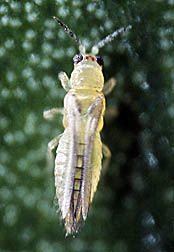This page has been archived and is being provided for reference purposes only. The page is no longer being updated, and therefore, links on the page may be invalid.
|
|
|
|
A Biocontrol for a Wide-Ranging Thrips
By Dennis O'BrienApril 28, 2009
A pest with a voracious appetite may have met its match in a predatory mite being evaluated as a biocontrol agent by Agricultural Research Service (ARS) scientists in Fort Pierce, Fla. in collaboration with University of Florida researchers.
The chilli thrips is an invasive pest that feeds on leaves, turns them brown, kills new growth and attacks up to 150 crops, including peppers, strawberries, tomatoes, peanuts, cotton and a variety of ornamentals.
Detected in Palm Beach County, Fla. in 2005, it has spread to 24 Florida counties and parts of Texas, damaging roses and other ornamentals in both states. Left unchecked, it could reach west to California and north along the Pacific Coast to Canada, causing losses of up to $3.8 billion annually.
Pesticides are effective, but the chilli thrips may develop resistance with repeated treatments, and pesticides are not an option for organic nurseries and gardeners, according to entomologist Cindy L. McKenzie, at the ARS U.S. Horticultural Research Laboratory in Fort Pierce.
Researchers at Fort Pierce and the University of Florida have turned to two mites, Neoseiulus cucumeris and Amblyseius swirskii, which have been used commercially to combat other pests since at least 2005. The researchers put 30 adult chilli thrips on ornamental pepper plants in greenhouse and outdoor settings, waited a week for thrips larvae to hatch and, in separate treatments, released 30 mites of each species on the plants. They checked the plants weekly for four weeks.
Their results, published in Biological Control, showed that the mites--particularly A. swirskii--significantly reduced the number of thrips. A. swirskii left no more than one thrips insect per leaf. That compared with up to 60 thrips larva found on leaves of untreated pepper plants. The work was funded in part by the American Floral Endowment and the Floriculture and Nursery Research Initiative.
The researchers have set up a chilli thrips website for gardeners and commercial growers at http://www.mrec.ifas.ufl.edu/lso/thripslinks.htm.
ARS is the principal intramural scientific research agency of the U.S. Department of Agriculture.

